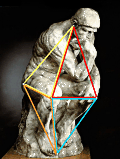

How to define the dimensions of a sculpture?
Moreover, we found that among Museums, no
uniform method of determining the dimensions of a sculpture has been
agreed upon. Whereas "height" mostly can be easily
defined,
"width" and "depth" measurements of an irregularly
shaped object always depend on subjective choices. Our conclusion was
that only objective geometrical models can accurately describe the
proportions of such an art work.  Therefore, we decided to make
non-contact measurements of Rodin sculptures, that will allow for an
exact morphological documentation of dimensions and surface structures.
Therefore, we decided to make
non-contact measurements of Rodin sculptures, that will allow for an
exact morphological documentation of dimensions and surface structures.
Some plaster versions (like the one in New York) are slightly smaller
than others, for example, because they have been cast after an existing
bronze cast. Foundry plasters that were duplicated by the foundry
workers may be less detailed than corresponding studio or exhibition
plasters. Some foundry plasters are worn off by casting processes or
have been mollified by chemical agents used in moulding. Some plasters
have even been cut apart for transport and were put together again. The
bronzes also vary, because the foundries uses different methods (lost
wax or sandcasting) and started from different plaster models. All these
differences, that may help to answer questions about the real age and
provenance of these copies, can only be determined by an exact
comparison in three dimensions.
Over the last three years we have tested many different
3D-Scanners in museum situations. Currently we work, according to the task to be
accomplished, with various kinds of equipment, which allow for a resolution of
up to 12 lines per millimeter while capturing spatial co-ordinates. This way,
the dimensions of a complex form can be determined very exactly. Moreover, not
only Height, Length and Depth, but also all proportions and surface
characteristics are recorded by this method.

